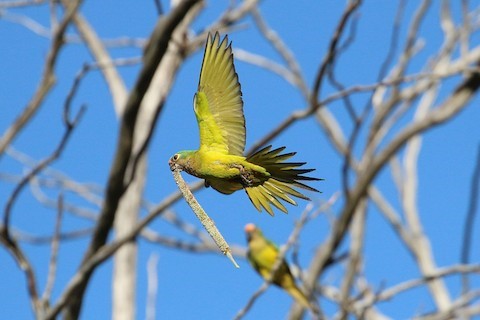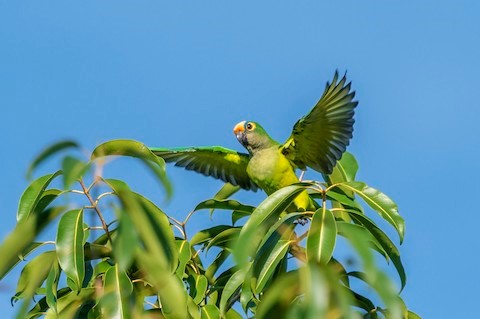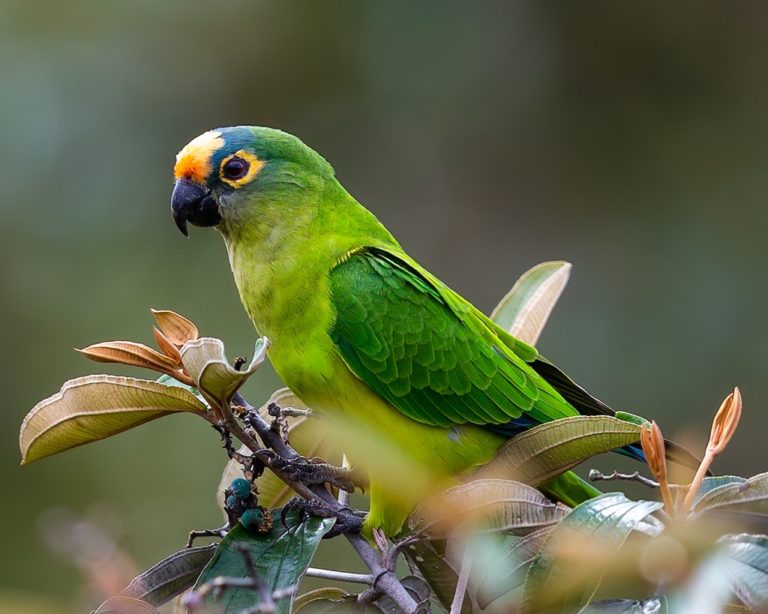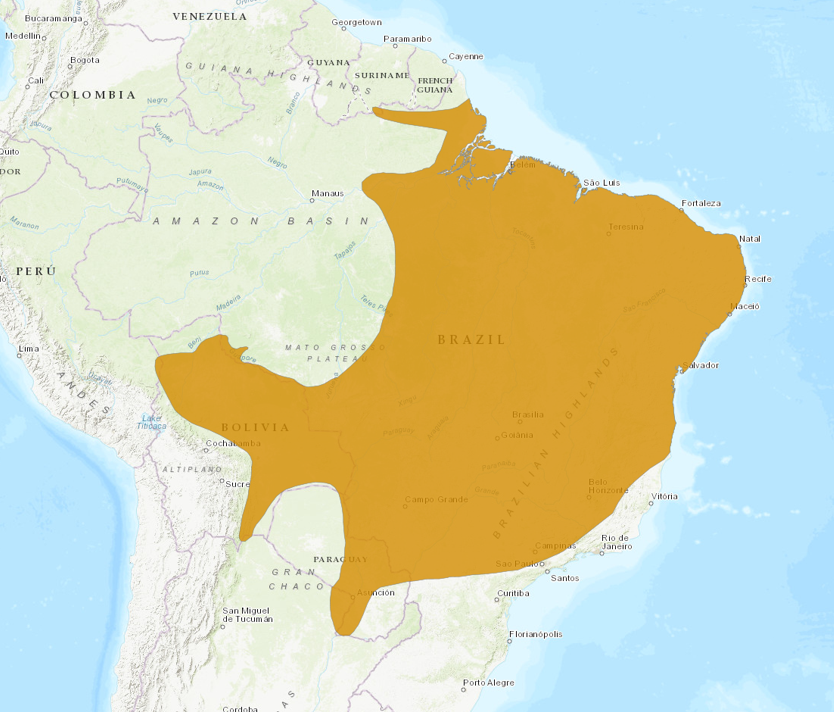Birdfinding.info ⇒ The predominant parakeet of Brazilian cerrado and semiopen habitats of the Atlantic Forest. Common and conspicuous in many areas of Brazil, including several of its principal cities: São Paulo, Rio de Janeiro, Belo Horizonte, and Brasília.
Peach-fronted Parakeet
Eupsittula aurea
Eastern South America.
Occupies a wide array of semiopen habitats, including open woodlands, savannas, and agricultural areas. Tolerant of development.
Occurs throughout the cerrado biome, and in other semiopen habitats of eastern South America north to Amazonas, Amapá, and southernmost Suriname, west to easternmost Peru (Pampas del Heath in Madre de Díos), south locally through the Paraná River valley of central Paraguay into northern Argentina (easternmost Formosa, barely into Chaco Province), and east throughout the Atlantic Forest lowlands of Brazil from eastern São Paulo north to Rio Grande do Norte.
Expanding its range locally into Amazonia, where it benefits from the clearance of forests for agriculture.
Generally absent from the caatinga biome (where the Cactus Parakeet replaces it), Brazil’s eastern mountains, and most of southern Brazil—common south to northwestern Paraná and central São Paulo, but rarely if ever reported farther south.
Identification
Green overall, with yellowish underparts, an olive throat, and colorful head: pale-orange forecrown, bordered with blue, and a wide pale-orange eyering.

Peach-fronted Parakeet. (Fazenda Santana dos Mello, Minas Gerais, Brazil; April 22, 2021.) © Fe Sofal

Peach-fronted Parakeet pair perched on a termite mound. (Cachoeira da Casca D’Anta, Serra da Canastra National Park, Minas Gerais, Brazil; May 15, 2019.) © Giovan Alex
The upperside of the flight feathers is mostly blue. In flight, the underside of the wings appears mostly yellow.

Peach-fronted Parakeet eating jaboticaba fruits, showing orange forecrown. (Linhares, Espírito Santo, Brazil; November 22, 2019.) © Gabriel Bonfa

Peach-fronted Parakeet in flight, showing uniformly yellowish undersides of the wings and tail. (Caverna Aroe Jari, Chapada dos Guimarães, Mato Grosso, Brazil; July 12, 2017.) © Leith Woodall
Notes
Polytypic species consisting of two recognized subspecies.
Additional Photos of Peach-fronted Parakeet

Peach-fronted Parakeet. (Goiás, Mato Grosso, Brazil; January 2021.) © abelardomendesjr

Peach-fronted Parakeet. (Figueirópolis, Tocantins, Brazil; March 7, 2018.) © Willian Menq

Peach-fronted Parakeet. (MONA do Morro da Pedreira, Federal District, Brazil; January 3, 2021.) © Marcelo Telles
References
BirdLife International. 2016. Eupsittula aurea. The IUCN Red List of Threatened Species 2016: e.T22685742A93084808. https://dx.doi.org/10.2305/IUCN.UK.2016-3.RLTS.T22685742A93084808.en. (Accessed January 8, 2022.)
eBird. 2022. eBird: An online database of bird distribution and abundance. Cornell Lab of Ornithology, Ithaca, N.Y. http://www.ebird.org. (Accessed January 8, 2022.)
Forshaw, J.M. 2010. Parrots of the World. Princeton University Press.
Juniper, T., and M. Parr. 1998. Parrots: A Guide to Parrots of the World. Yale University Press.
Schulenberg, T.S., D.F. Stotz, D.F. Lane, J.P. O’Neill, and T.A. Parker. 2007. Birds of Peru. Princeton University Press.
van Perlo, B. 2009. A Field Guide to the Birds of Brazil. Oxford University Press.
Wikiaves. 2022. Periquito-rei, https://www.wikiaves.com.br/wiki/periquito-rei. (Accessed January 8, 2022.)
Xeno-Canto. 2022. Peach-fronted Parakeet – Eupsittula aurea. https://xeno-canto.org/species/Eupsittula-aurea. (Accessed January 8, 2022.)

